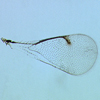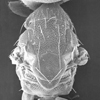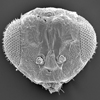
 |
 |
 |
||||
 |
 |
|||||
 |
 |
|||||
Classification
Superfamily : Chalcidoidea
Family : Eulophidae
Subfamily :
Eulophinae
Tribe :
Cirrospilini
Notauli
complete and curving to axilla
(ax) at a distance well separated from posterior margin of mesoscutum;
midlobe of mesoscutum with 2 pair of setae.
Body
colour : dorsum of mesosoma predominantly metallic, with posterior
half of axilla yellow and non-metallic; head and metasoma with extensive
yellow markings.
Flagellum with 2 funicular
segments in both sexes and club
3-segmented.

Diagnosis
Distribution
ASIA: India, Malaysia, Taiwan, Vietnam
AFRICA: South Africa, Tanzania
(Noyes,
2002; 2003)
Hosts
Agromyzidae: Liriomyza sativae Blanchard, L. trifolii (Burgess) and Calycomyza lantanae (Frick) (Noyes, 2002;2003).
Biology
La Salle, 1996; Noyes, 2002; 2003). No further biological information is available. This is a relatively widespread parasitoid, but it does not appear to have significant impact on host populations.
Comments
C. ambiguus may be quite easily distinguished from all the other
Cirrospilus
by the notauli, which curve to meet the anterior margin of axilla, rather
than extending to the hind margin of mesoscutum. All other Cirrospilus
have the latter character, which has generally been used as one
of the main features to distinguish Cirrospilus
from Zagrammosoma
and Diglyphus.
In the description of C. ambiguus (Hansson
&
La Salle, 1996), the authors preferred to place this species in Cirrospilus
because it doesn't have other characters usually associated with Zagrammosoma
or Diglyphus
: it is mainly metallic in coloration and without a vaulted vertex, while
Zagrammosoma
has vaulted vertex and is always non-metallic; some yellow markings are
present, while Diglyphus
are always completely metallic.